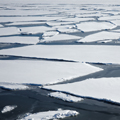Monitoring Maine Lake Temperatures in a Changing Climate
 Partnership for Monitoring Maine Lake Temperatures in a Changing Climate, Short Term Variability and Long Term Trends
Partnership for Monitoring Maine Lake Temperatures in a Changing Climate, Short Term Variability and Long Term Trends
Institutions: University of Maine Farmington, Maine Volunteer Lake Monitoring Program
Sponsor: Maine Water Institute (WRRI Program)
Temperature records over the last fifty years have indicated that global temperatures have risen between 0.014 to 0.017 0 C/year, with greater fluctuations being found during that time depending upon geographical region (Salinger, 2005, IPCC 2007). For over thirty years authors have been projecting the potential impact that increased temperatures will have upon terrestrial habitats and their biological communities. In the last two decades researchers have studied and/or modeled the impact that this changing climate is having upon various seasonal attributes of aquatic environments such as ice cover and flow regimes of streams (Huntington et al, 2003), onset of ice cover and ice out (Hodgkins et al. 2005; Mishra et al, 2011), lake stratification patterns (Trolle et al, 2011) and the epilimnetic temperatures of some of our largest lakes (Austin and Coleman, 2007; Sahoo et al, 2011). Despite the increase in research on the impacts of climate change upon lake habitats, and the long-standing efforts of lake monitoring groups in Maine to provide information on local lakes, there exists relatively little high quality data on seasonally related water temperatures in the state. This lack of high quality, high density temperature data is a problem in that it adds a significant amount of noise to any analysis of how long terms climatic trends are affecting Maine lake temperatures. We need this data in order to analyze and better understand how factors such as basin morphology, elevation, location, or water color/turbidity might influence various aspects of a given lake’s thermal response. Our current lack of data on the regional magnitude of temperature change in Maine’s lakes diminishes our ability to comprehend how these ecosystems have been and are going to be changed. This in turn hampers resource utilization and management programs for public and private water supplies at a time when these resources are coming under increased consumer pressure. Other programs that may to be impacted by changing water temperatures and hydrological regimens include local and state efforts in sewage treatment, pollution control, erosion abatement, nutrient management, management of invasive species, and fish stocking.
Team Members:
- Dan Buckley, University of Maine Farmington (team leader)
- Scott Williams, Maine Volunteer Lake Monitoring Program
